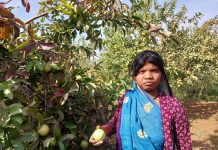A tree planting initiative known as the Mukhya Mantri Vriksh Sampada Yojana has identified 36,000 acres for plantation outside forests in the first year as part of a five-year plan, writes Deepanwita Gita Niyogi
As part of a special initiative, farmers in Chhattisgarh will reap monetary benefits for planting trees in unused lands. The initiative known as the Mukhyamantri Vriksh Sampada Yojana has identified 36,000 acres this year for plantation outside forests. In total, 180,000 acres will be covered in five years.
The project will contribute to farmers’ income. To help them, a buyback agreement has been prepared and it is pending approval at present. The beneficiaries will also be able to take carbon credit.
To ensure that the programme is a success, the forest department staff have undergone intensive training. Short duration species like eucalyptus and meliadubia as well as fruit trees will be distributed among farmers.
Earlier, under the Mukhya Mantri Vriksharopan Protsahan Yojana, if farmers shifted from paddy cultivation to tree plantation, they received Rs 10,000 per acre for three years as incentive.
“Farmers have been identified already. Under the initiative, there is a tripartite agreement among companies, the Chhattisgarh government and farmers. The buyback price will be decided by the forest department through a committee. It is a win-win for all stakeholders,” said additional principal chief conservator of forest, land management, Sunil Kumar Mishra.
Tree planting scheme
Under the Mukhyamantri Vriksh Sampada Yojana, tree planting will be carried out during the monsoon. Species like teak and bamboo will be planted in irrigated lands. However, on March 21, there was symbolic planting across the state on the occasion of the International Day of Forests.
Durjan Kashyap, the sarpanch of Dilmili in Bastar district, said fruit trees will be distributed by the forest department. For the purpose of planting, pits will be dug and these can be prepared under MGNREGA. Dilmili is already experimenting with coffee plantation. For the tree planting scheme, coordination between farmers and the forest department is on.
As part of the initiative, which is basically an agroforestry model, consultants will be hired for buying carbon credit. Mishra added that the government wants to increase trees outside forest through this scheme. There will be plantation along roadsides and river banks too.
Though there are many definitions of agroforestry, generally it is a combination of agriculture and trees in an area. According to Starry Sprenkle-Hyppolite, restoration science senior director at Conservation International, full-sun-crops like corn, wheat and soy can tolerate a light level of agroforestry, like widely-spaced lines of trees or trees around field boundaries. Depending on the climate, trees may help ensure production of these crops in drought because they reduce soil temperature and evapotranspiration, thereby reducing water stress on crops.
“Some trees make better neighbours for crops. Those that take a lot of water and have shallow root systems like eucalyptus and neem tend to compete with crops and make yields go down. Eucalyptus isn’t good for the environment or agriculture, not just for water competition but also for the chemicals in leaves. But deep-rooted trees can help lift groundwater to the surface, thus benefitting crops,” Hyppolite said.
Value of trees outside forests
For carbon sequestration, trees outside forests are important. There are far more hectares of managed lands compared to forest lands as majority of the Earth’s non-desert surface is being used either for agriculture or for grazing. Thus, increasing tree densities up to levels that are compatible with food production is one of the natural climate solutions.
Under the Chhattisgarh government’s scheme, beneficiaries will receive 100 percent subsidy for five acres. If the area increases beyond that, there will be 50 percent subsidy.
Agroforestry is a good approach to defeat deforestation and increase forest cover. “Agroforests provide sustainable sources of fuelwood and timber. There is one argument against this which assumes that food production is less when trees share fields with crops. However, research suggests there are sustainable levels of tree integration that don’t decrease crop yields. Trees also survive drought in a much better way than crops,” Hyppolite added.
Trees outside forest are counted in the Forest Survey of India reports too. But though they increase tree cover, agroforests are not the same as natural forests.
Under the Chhattisgarh model, the number of nilgiri trees will be 900-1000 per acre, said CR Sori from the forest department based in Dantewada district. Nilgiri is sold to contractors at Rs 4 per kg. Those having borewells will get tissue culture trees of hybrid quality which will mature in four years.
Anil Karma, the sarpanch of Paraspal village in Dantewada, is happy with the new scheme but threw in a word of caution. He said under previous such exercises, the forest department did not take much care and many saplings were damaged by cattle.
To encourage farmers, the Chhattisgarh government is trying to fix a minimum purchase price for meliadubia, bamboo and eucalyptus every year, said Rajesh Kallaje from the forest department, who worked extensively on the project. The number of trees will also depend on the spacing. Whereas there will be 900 -1000 trees per acre in case of nilgiri, for teak it will be 250 trees per acre, for sandalwood 160 trees per acre, and for bamboo 450 trees per acre.
Meliadubia appears to be better suited for agroforestry than eucalyptus. It loses its leaves each year which means that it will increase soil organic matter, help in water retention and increase fertility. “It requires a lot of water for fast growth and so can cause problems in dry areas. But it is a timber tree with valued wood,” said Hyppolite.













